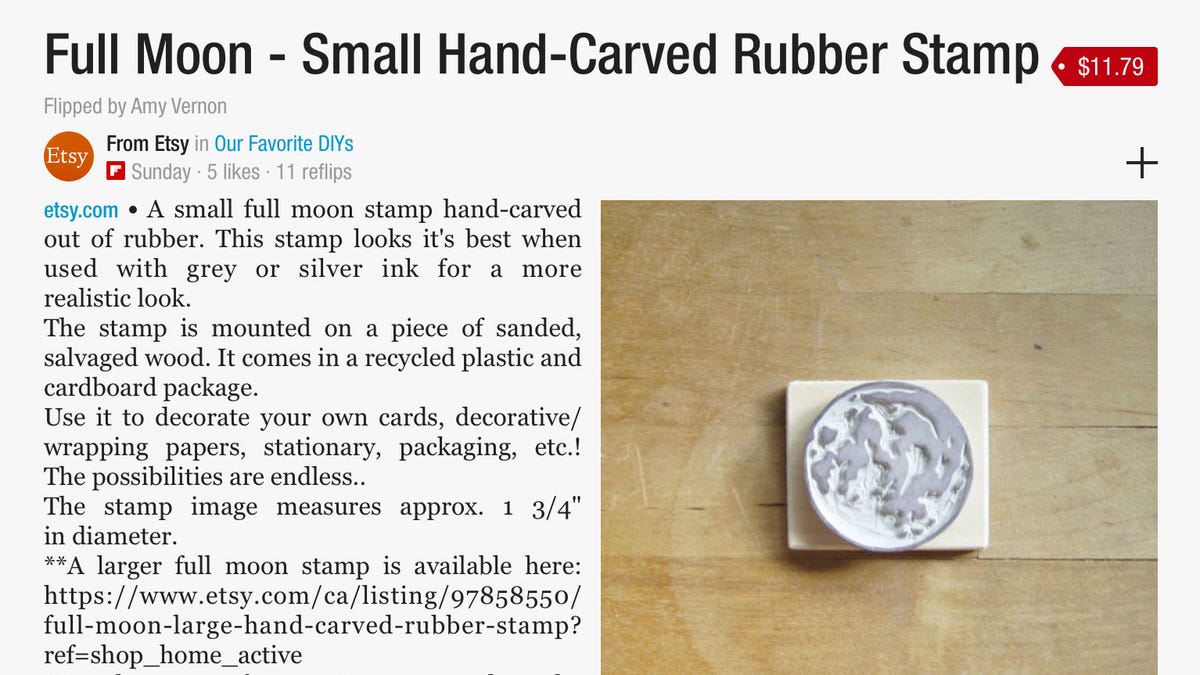Flipboard expands into mobile commerce with catalog feature
The social magazine app has broadened its commerce ambitions with a new catalog section, letting users and brands alike curate products with price tags and purchase links.

Flipboard, the social magazine app for iOS and Android, is extending its feelers further into mobile commerce with a new catalogs category. The update, released Monday, allows companies and individual users to create specialized buying guides out of items found within Flipboard and on the Web. The guides can then be deposited into custom magazines with price tags and product info alongside active links to allow purchases.
Back in March, Flipboard -- which in September raised another $50 million on a $800 million valuation -- introduced its magazine-creating feature in its 2.0 update. That extended the app's curation tool, previously reserved for large publisher's RSS and social channels as well as Flipboard's in-house editorial teams, to all of its users.
Since then, 4.5 million magazines have been created. Flipboard has 90 million activations, though the company has yet to release daily active user figures in quite some time.
The catalog tool is a Pinterest-like application of that curation ability in which the app's magazines double as places to display and seek out purchasable items. This is not the first commerce-related addition to Flipboard's ecosystem. In March, the company announced integration with Etsy and just last month brought Levi's onboard to promote a Flipboard-specific lifestyle magazine, moves that now seem very much a precursor to this catalogs launch.
To jumpstart its commerce activity, Flipboard is launching 11 product-oriented magazines curated by its editorial team, as well as bringing on celebrities like fashion designer Cynthia Rowley and chef Daniel Boulud to create catalogs of their favorite products.
With this feature, Flipboard hopes to cater to high-profile commerce brands in much the same way it fosters partnerships with journalistic and entertainment outlets. It's already partnered with Banana Republic, Fab, eBay, ModCloth, and BirchBox so that it had specially designed catalogue at launch that will, depending on the brand, mix editorial content in the way Levi's has been doing with its products.
The catalog-creation process is said to take roughly two to three weeks and can be done for any retailer with a large audience. However, it's not explicitly clear what constitutes a "premium" brand and which companies can and can't have their content customized by the Flipboard team.
"It's similar to what we do with publishers: We create series of templates for different device screens, and map them to their look and feel," Flipboard CEO Mike McCue said an interview with CNET. "Once we have it right, we flow their product content into template. Flipboard does the work of creating templates, and partners give us content feeds and do the curating."
Flipboard will not be taking a cut of any commerce activity, nor charging for the catalog creation. "It's meant to be a starting point," McCue said. "By having the product look this way, it will drive more readers and more discovery of products by retailers."
Where it will attempt to make money is still through its advertising model. Flipboard's ads have always relied on the aesthetic -- and the higher-end cost -- of full-page magazine print ads. With catalogs, it hopes to expand that advertising in a more targeted way, allowing for brands like Banana Republic to advertise their products within its catalogs on top of advertising those catalog elsewhere within Flipboard.
"We are going to put energy into being the preeminent brand advertising place," McCue added.
All of this is not to say that only established brands can utilize Flipboard's catalog feature. Anyone, from Etsy craftmakers to Shapeways designers selling 3D printed ceramics, can create a custom catalogue equipped with price tags and purchase links. The only difference is that the content will not be specially paginated -- Flipboard's term for the way in which it divides and designs content into multiple, flippable pages -- in the way that large brands and publishing partners' content is.
Still, Flipboard's venture into commerce is not entirely designed with the same clean and smart finish as the app. When clicking a "buy now" link, users are taken to an often-times clunky mobile Web site to complete the purchase. McCue hopes to change that with deeper integration. "In the long run, we want to make the experience of Web sites like Banana Republic more optimized for touch," he said.
While Flipboard is financially comfortable thanks to its recent funding round, the company is still one to two years away from probability, McCue forecasted.
McCue's ultimate vision would have Flipboard at the center of all content, where users would stay within the app to read news, watch Hulu and Netflix, and listen to the radio while browsing Instagram and Twitter. It's seeking out ways to make that a more attractive alternative. It already has integration with YouTube and Soundcloud, but has yet to become a singular destination for video, though that may change now that its ranks include former Hulu CTO Eric Feng.
Of video and music, Flipboard has "just scratched the surface," McCue said
Disclaimer: As noted in my bio below, prior to joining CNET I was employed as a contract curator as part of Flipboard's news team. I did not hold a staff position, nor was I involved in any app development or design processes.

